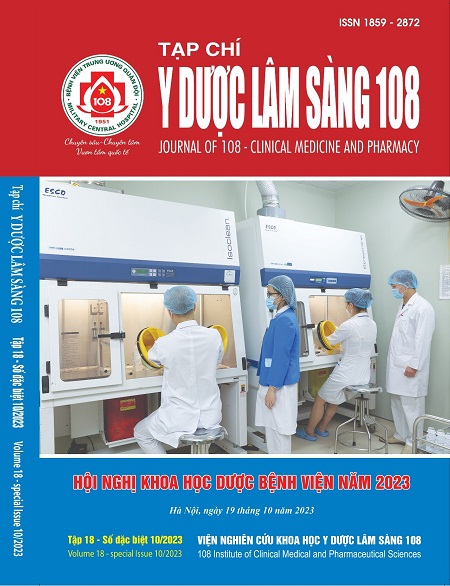The effectiveness of the managing cardiovascular drug - disease interactions in outpatient at Ha Dong General Hospital
Main Article Content
Keywords
Abstract
Objective: To analyze the effectiveness of managing cardiovascular drug-disease interactions in outpatients through clinical pharmacy activity at Ha Dong General Hospital. Subject and method: Intervention study, comparing the pre-intervention and post-intervention periods through warnings of cardiovascular drug-disease interaction pairs on the software when doctors prescribe. During the pre-intervention phase, the research team reviewed cardiovascular drug-disease interactions from September 2022 to October 2022. The post-intervention phase, on the other hand, evaluated the effectiveness of drug-disease interaction management from January 2023 to February 2023. Result: The results showed that the patients in this study were elderly (mean age: 67.4 ± 11.5 in the pre-intervention period and 68.8 ± 10.2 in the intervention period), using many drugs in both stages, respectively: 4.6 ± 2.0 and 3.2 ± 13. After the pharmacist intervened, the number of cardiovascular drug-disease interactions reduced from 49 (0.213%) to 7 (0.029%). Interaction pairs that still occurred after interfering were thiazide - Severe renal failure, bisoprolol - Severe asthma, aspirin - Peptic ulcer. Conclusion: The warning system for cardiovascular drug-disease interactions in the software, triggered when doctors prescribe medications, has been effective. The rate of these interactions in the post-intervention period significantly decreased compared to the pre-intervention period (p<0.05)
Article Details
References
2. Lindblad CI, Artz MB et al (2005) Potential drug-disease interactions in frail, hospitalized elderly veterans. Ann Pharmother 39(3): 412-417.
3. Shastay A (2017) The Absence of a drug-disease interaction alert leads to a Child's Death. Home Healthe Now,35(5): 285-287.
4. Schedlbauer A, Prasad V et al (2009) What evidence supports the use of computerized alerts and prompts to improve clinicians' prescribing behavior?. J Am Med Inform Assoc 16(4): 531-538.
5. Trần Thu Phương và cộng sự (2022) Xây dựng danh mục tương tác thuốc tim mạch - bệnh cần chú ý trong thực hành lâm sàng tại Bệnh viện Đa khoa Xanh Pôn. Tạp chí Y Dược học, số 46, pp 65.
6. Weddle SC, Rowe AS et al (2017) Assessment of clinical pharmacy interventions to reduce outpatient use of high-risk medications in the elderly. J Manag Care Spec Pharm,23(5): 520-524.
7. Doubova Dubova SV, Reyes-Morales H et al (2007) Potential drug-drug and drug-disease interactions in prescriptions for ambulatory patients over 50 years of age in family medicine clinics in Mexico City. BMC Health Serv Res 7: 147.
8. Pugh MJ, Starmer CI et al (2011) Exposure to potentially harmful drug- disease interactions in older community-dwelling veterans based on the Healthcare Effectiveness Data and Information Set quality measure: who is at risk?. J Am Geriatr Soc 59(9): 1673-1678.
9. Schmidt MK, Andersen M et al (2020) Drug-disease interactions in Swedish senior primary care patients were dominated by non-steroid anti- inflammatory drugs and hypertension - a population-based registry study. Scand J Prim Health Care 3813): 330-339.
10. Nguyễn Thành Hải và cộng sự (2023) Hiệu quả của việc quản lý tương tác thuốc tim mạch-bệnh trên bệnh nhân điều trị nội trú thông qua phối hợp hoạt động dược lâm sàng và hệ thống cảnh báo trên phần mềm kê đơn tại Bệnh viện Đa khoa Xanh Pôn. Tạp chí Y học Việt Nam tạp 525 - tháng 4 - số 1a, tr. 303-307.
 ISSN: 1859 - 2872
ISSN: 1859 - 2872
